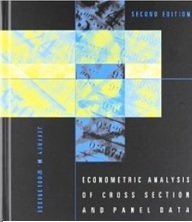
![]()
Econometric Analysis of Panel Data
Professor William Greene
![]()
|
|
|
|
This is an intermediate level, Ph.D. course in the area of Applied Econometrics dealing with Panel Data. The range of topics covered in the course will span a large part of econometrics generally, though we are particularly interested in those techniques as they are adapted to the analysis of 'panel' or 'longitudinal' data sets. Topics to be studied include specification, estimation, and inference in the context of models that include individual (firm, person, etc.) effects. We will begin with a development of the standard linear regression model, then extend it to panel data settings involving 'fixed' and 'random' effects. The asymptotic distribution theory necessary for analysis of generalized linear and nonlinear models will be reviewed or developed as we proceed.. We will then turn to instrumental variables, maximum likelihood, generalized method of moments (GMM), and two step estimation methods. The linear model will be extended to dynamic models and recently developed GMM and instrumental variables techniques. The classical methods of maximum likelihood and GMM and Bayesian methods, expecially MCMC techniques, are applied to models with individual effects. The last third of the course will focus on nonlinear models. Theoretical developments will focus on heterogeneity in models including random parameter variation, latent class (finite mixture) and 'mixed' and hierarchical models. We will also visit the theory for techniques for optimization in the setting of nonlinear models. We will consider numerous applications from the literature, including static and dynamic regression models, heterogeneous parameters models (e.g., Fama-Macbeth), random parameter variation, and specific nonlinear models such as binary and multinomial choice and models for count data. The discussion will include elements of the following topics:
The Paradigm of Econometrics
Aspects of Panel Data
Fixed and Random Effects in Static Models
Heteroscedasticity, Autocorrelation, Robust Estimation
Asymptotic Theory and Instrumental Variables Estimation
Dynamic Regression Models, IV and GMM Estimation
Nonlinear Models
Random Parameter Variation, Mixed Models, Discrete and Continuous Variation
Nonlinear Models: Discrete Choice Models, Models for Counts